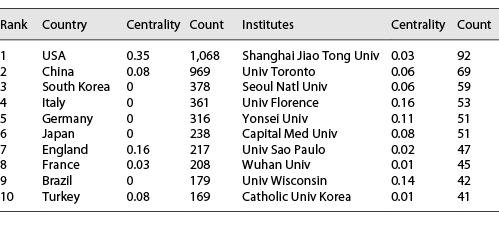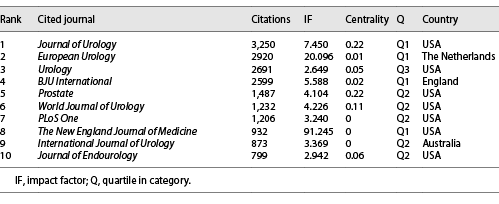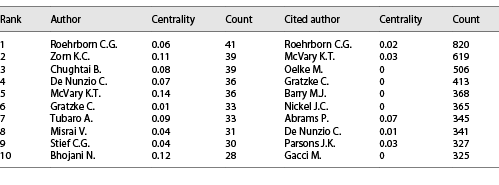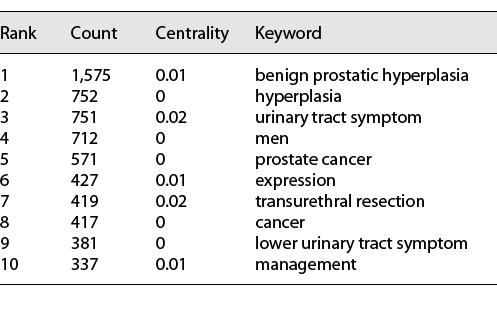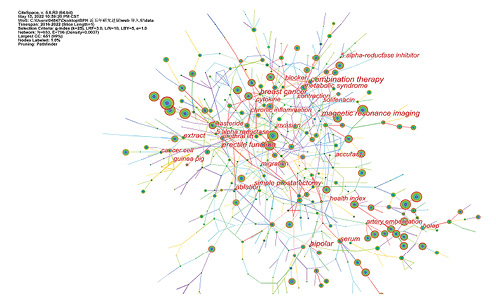Abstract
Background: Benign prostatic hyperplasia (BPH) is a common urological disorder leading to dysuria in middle-aged and elderly men and significantly reduces the quality of life of patients. Technology for BPH has made a great progress, while there is still a lack of visual and summary literature to make the summary. Summary: The aims of the study were to identify the cooperation of authors, countries, institutions, and explore hot topics’ prospects regarding research of BPH. Relevant original articles were obtained from the Web of Science (WoS) database between 2016 and 2022. CiteSpace software was used to perform the analysis and visualization of scientific productivity and emerging trends. Key Messages: A total of 4,738 articles related to study of BPH were identified. We observed a gradual increase in the number of publications from 2016 to 2022. The USA dominated the field in all countries. Shanghai Jiao Tong University was the most productive institution in 6 years. Active cooperation between countries and between institutions was not observed. Journal of Urology was the most co-cited journal. Roehrborn CG (41 papers) was the most productive author and had the largest numbers of citations (820 co-citations) during the past 6 years. Close collaboration was not observed between the different authors. The main hot topics included matters related to BPH, urinary tract symptom, prostatic urethral lift, thermal therapy, and prostatic neoplasms. This scientometric study comprehensively reviewed publications related to BPH during the past 6 years using quantitative and qualitative methods, which can be used to forecast future research developments in BPH.
Introduction
Human prostate is a walnut-sized organ situated at the bottom of the bladder. Benign prostatic hyperplasia (BPH) is one of the principal causes of its pathogenesis [1]. Studies have shown that BPH is a common urological disorder leading to dysuria in middle-aged and elderly men. Lower urinary tract symptoms (LUTS) caused by BPH can be characterized by the following symptoms: storage symptoms including pollakiuria, nocturia, urinary urgency, and urinary incontinence; voiding symptoms including dysuria, postvoid residual urine volume, postmicturition symptoms, and need to strain to urinate [2]. It may go hand in hand with other manifestations such as abdominal bloating or lumbosacral tenderness, and in severe cases, secondary symptoms such as acute urinary retention or upper urinary tract lesions. The occurrence of BPH not only significantly reduces the quality of life of patients [3], but also has a great impact on the physical and mental health of patients, which lead to a series of profound social and economic burdens. Most patients with BPH begin to develop clinical symptoms around the age of 50 years, with an incidence of more than 50% in men aged 60 years and up to 80% at age 80 [4]. As the population ages and life expectancy increases, men enjoy higher life expectancy and lower competitive mortality rates, predicting a continued accelerating wave of BPH. These epidemiological trends pose a meaningful challenge to urologist worldwide.
Anatomic illustrations of the prostate have been published by Andreas Vesalius, in 1,543 [1]. BPH is associated with interstitial and epithelial compartment hyperplasia states. 5a-reductase type 2 and androgen are important to the development and maintenance of the prostate [5]. Multiple growth factors, chronic inflammation, and hormones also play significant roles in the evolution of BPH. Increased oxidative stress, changes in hormone levels with age, and loss of cell cycle regulators are other proposed mechanisms for BPH progression [6, 7].
Management of BPH patients is complex. There are various methods to treat storage symptoms and voiding symptoms [8]. For storage symptoms, muscarinic receptor antagonists and β3-adrenoceptor agonists can be used. For urinary dysfunction, alpha1 receptor inhibitors (alpha blockers), phosphodiesterase 5 inhibitors (PDE5-IS), or 5-alpha reductase inhibitors can be utilized. 5-alpha reductase inhibitors can inhibit the generation of dihydrotestosterone, induce apoptosis in the epithelial cells, reduce the size of the prostate gland and prostate-specific antigen levels, thereby inhibiting the progression of hyperplasia [9]. A recent meta-analysis compared the effects of PDE5-IS against alpha blockers alone or placebo. As a new alternative therapy, PDE5-IS has a positive impact on improving LUTS caused by BPH [10]. The use of plants and herbs (phytotherapy) to treat BPH-induced LUTS has been growing steadily in most Western countries. For example, the extract of the berry of the American saw palmetto or any others [11]. For nocturia, the vasopressin analogue desmopressin may be used, which can promote the reabsorption of water and reduce urinary production [12]. In addition to existing monotherapy regimens, combination therapy may also be considered.
Surgical treatment is the principal method of treating BPH. Surgery and minimally invasive procedures can make patients have fewer symptoms and are specifically recommended for treatment of BPH-related complications [13]. Transurethral prostatectomy (TURP) is the gold standard for surgical treatment of BPH. However, for large-volume prostatic hyperplasia (>80 mL), open surgical resection is advised. Various new surgical techniques have made great progress in recent years, including various types of enucleation and resection procedures, but the long-term effects still need to be determined. Prostatic urethral lift (PUL) procedure uses nitinol-coated implants to compress the prostatic lobes of the prostate, which can preserve erectile function and anterograde ejaculation [14]. In addition, there are other types of surgery, Rezum and Aquablation. Rezum is a procedure which uses convective water vapor energy to ablation of the prostate. And another one is a kind of hydrodissection which is based on robot-assisted [15].
CiteSpace is a web-based Java application for data analysis and visualization [16]. CiteSpace software includes co-citations, co-authors, and co-occurrence keywords [17], which helps predict trends in research. CiteSpace Atlas provides an intuitive visual representation of trends in a discipline or area of knowledge over a certain period of time, and analyzes the evolution of numerous research frontiers. Technology of BPH has made a great progress, while there is still a lack of visual and summary literature. This study investigates the research trends of BPH development based on CiteSpace’s document visualization analysis.
Data Source and Search Strategy
The Web of Science core collection online database was queried with the following search string: TS = (“prostatic hyperplasia” OR “hyperplasia, prostatic” OR “benign prostatic hyperplasia” OR “hyperplasia, benign prostatic” OR “prostatic hyperplasias, benign” OR “hypertroph*, prostatic” OR “prostatic hypertrophy, Benign”). Articles that meet the following criteria were enrolled: (1) the time span is between 2016 and 2022; (2) articles on research of BPH, including original and review articles. The following documents were excluded: (1) meeting abstracts, letters, irrelevant proceedings, and repeated articles; (2) articles not written in English.
Statistical Analysis
CiteSpace 5.7.R5 was used for bibliometric analysis to obtain visual knowledge maps of countries, authors, institutions, and keywords related to BPH research. The visualized knowledge graph consists of nodes and links, and the links between nodes represent cooperative/co-occurrence or joint relationships. Specifically, software parameters were selected: Time Slicing – January 2016 to May 2022, each year was chosen as a time slice. Author, institution, country/region, references, keywords, and so on were chosen for analysis one by one. G-index was chosen as the analytical criterion. Pathfinder, pruning sliced networks, and pruning the merged network were selected as pruning criteria. Modularity Q (Q) and weighted mean silhouette (S) were used to measure the cluster degree, Q > 0.3 means a significant clustering structure, and S > 0.5 shows that the clustering results are acceptable. According to different node types, authors, institutions, and keywords were taken as nodes, respectively, to perform visual atlas analysis on the included literature.
Annual Publications
A total of 4,738 publications, including 4,062 articles and 676 reviews, were collected, from 2016 to 2022. The trend could be observed from Figure 1. Research enthusiasm for BPH has gradually been increasing since 2016. The number of publications has exceeded 700 each year; especially in the last 2 years, the number of studies has exceeded 800. BPH research continues to be a focus in the field of studying.
Output of articles and growth prediction of BPH research from 2016 to 2022.
Output of articles and growth prediction of BPH research from 2016 to 2022.
Distribution of Countries/Regions and Institutions
Articles published from 2016 to 2022 were chosen, and we reviewed with a time slice of 1 year. A total of 124 countries/regions and 375 institutions had contributed related articles in this field. The country/region and institution collaboration networks of BPH were observed (Fig. 2, 3). Table 1 shows the 10 most productive countries/regions and institutions in this field. The number of nodes is 124, and the number of links is 131 in the country/region map (destiny = 0.0172). Countries are linked to each other although the cooperative structure is still loose, relatively. The USA had the most publications, with 1,068 articles published, followed by China (969 papers), South Korea (378 papers), Italy (361 papers), Germany (316 papers), and Japan (238 papers). Specially, countries which had greater centrality were the USA and the UK. Correspondingly, purple circles representing high centrality could be observed in the nodes of the USA and the UK, indicating that these countries were more concentrated in the field of PBH. Institutional collaboration network had 375 nodes with 501 links (destiny = 0.0071). Connection and cooperation between various institutions could be observed, but the degree of cooperation was not sufficient. Top 5 institutions were Shanghai Jiao Tong Univ (92 papers), Univ Toronto (69 papers), Seoul Natl Univ (59 papers), Univ Florence (53 papers), and Yonsei Univ (51 papers). Yonsei University and University Florence had greater centrality (no less than 0.1), the results showed that the study of BPH by these two institutions was more concentrated, and the purple outer ring could be observed at the corresponding nodes on the map.
Country/region collaboration network of BPH research from 2016 to 2022.
Country/region collaboration network of BPH research from 2016 to 2022.
Institutions collaboration network of BPH research from 2016 to 2022.
Institutions collaboration network of BPH research from 2016 to 2022.
Analysis of Cited Journals
A total of 942 scholarly journals had made contributions to BPH research. Table 2 indicates the top 10 cited journals on BPH research. The most cited journals were Journal of Urology (3,250 times), followed by European Urology (2,920 times), Urology (2,691 times), and BJU International (2,599 times).
Analysis of Authors and Cited Authors
Enrolled articles from 2016 to 2022 were analyzed with a time slice of 1 year. A total of 456 core first authors published papers on BPH field. Figure 4 shows the authors network map, which had 456 nodes with 964 links (destiny = 0.0093). The five most productive authors were Roehrborn C.G. (41 papers), Zorn K.C. (39 papers), Chughtai B. (39 papers), De Nunzio C. (36 papers), and McVary K.T. (36 papers). Zorn K.C. and McVary K.T. had a centrality greater than 0.1. The purple outer circle could be observed on the map, indicating that the two authors’ respective studies were relatively concentrated. The co-cited authors’ visualization map is given in Figure 5. There were 832 nodes and 882 links in it (destiny = 0.0026). The authors who are most frequently co-cited hold the largest nodes, including Roehrborn C.G. (820 citations), McVary K.T. (619 citations), Oelke M. (506 citations), Gratzke C. (413 citations), and Barry M.J. (368 citations). Table 3 describes the 10 most productive authors and cited authors.
Author collaboration network of BPH research from 2016 to 2022.
Author collaboration network of BPH research from 2016 to 2022.
Cited author collaboration network of BPH research from 2016 to 2022.
Cited author collaboration network of BPH research from 2016 to 2022.
Analysis of Cited References
Enrolled articles from 2016 to 2022 were analyzed with a time slice of 1 year. The corporation network map is shown in Figure 6, which had 750 nodes with 741 links (destiny = 0.0026). Gratzke et al. [18], with 221 citations, followed by Oelke et al. [19] with 183 citations, Cornu et al. [20] with 174 citations, Egan [21] with 104 citations, Carnevale et al. [22] with 99 citations, Roehrborn et al. [23] with 98 citations, Thomas et al. [24] with 94 citations, Foster et al. [25] with 86 citations, Gilling et al. [26] with 76 citations, and Gratzke et al. [27] with 74 citations were the 10 highest citation papers (Table 4). Cornu et al. [20] and Roehrborn et al. [23] had greater centrality (no less than 0.1). The results showed that the study of BPH by these two authors was more concentrated. Figure 7 also shows the timeline view of the co-citation references, reflecting the changes of research hot spots over time. Through the analysis of the references, we concluded that “enucleation” (cluster #9) had the warmest color, suggesting that enucleation is getting more focus in BPH during the past 5 years. From 2011 to 2015, many keywords in references contained “obesity” (cluster #3), “inflammation” (cluster #4), and “photoselective vaporization of prostate” (cluster #6), suggesting that these were the research hot spots at that time. Figure 8 shows the top 15 references with the strongest citation bursts. The first seven references highlighted the emerging trend of BPH research at 2016–2017, while the middle one indicated the emerging trend at 2018–2019. Last seven references were paid a lot of attention from 2020 to 2022.
Cited reference collaboration network of BPH research from 2016 to 2022.
Cited reference collaboration network of BPH research from 2016 to 2022.
Timeline view of the cited reference knowledge map in BPH research from 2016 to 2022.
Timeline view of the cited reference knowledge map in BPH research from 2016 to 2022.
Top 15 references with the strongest citation bursts in the co-citation network.
Top 15 references with the strongest citation bursts in the co-citation network.
Analysis of Keywords and Keyword Co-Occurrence Clusters
Keywords indicate hot spots and trends in a research field [28]. Keyword analysis can also indicate the study trends in a specific area. We visually analyzed the keywords with BPH in the included literature. There were 653 keywords with 796 articles on the map (Fig. 9). The most popular keywords were “benign prostatic hyperplasia,” “hyperplasia,” “urinary tract symptom,” “men,” and “prostate cancer” (Table 5). Clusters of keywords were visualized in the network map (Fig. 10). Cluster #0 labeling the “index” was the largest cluster, followed by “prostate cancer” (cluster #1) and “gene expression” (cluster #2). According to timeline view of the keyword clusters (Fig. 11), several research directions, including “prostate cancer” (cluster #1), “prostatic neoplasms” (cluster #4), and “prostatic urethral lift” (cluster #8), were also the research hot spots in this field.
Keyword collaboration network of BPH research from 2016 to 2022.
Keyword collaboration network of BPH research from 2016 to 2022.
Timeline view of the keywords in articles related to BPH.
Timeline view of the keywords in articles related to BPH.
Analysis of Burst Keywords
Articles with keyword bursts show a significant increase in different research interests in the field of BPH. Among the top 81 keywords with the strongest citation bursts in this field, Figure 12 shows the 15 top burst keywords that we focused on. In particular, the keywords that appeared to burst in 2016–2017 were “late onset hypogonadism” (burst strength is 5.57), “angiogenesis” (burst strength is 4.52), and “pressure flow” (burst strength is 4.17); “120w laser” (burst strength is 4.51), “silodosin” (burst strength is 4.00), and “sildenafil citrate” (burst strength is 4.19) burst from 2018 and ended in 2020, “prostatic urethral lift” (burst strength is 6.29), “induction” (burst strength is 5.91), and “thermal therapy” (burst strength is 7.43) appeared from 2021 and continued.
Discussion
BPH research is always a focus on studying. Over the past 6 years, the number of articles related to BPH has gradually increased, as shown in Figure 1, indicating that researchers are gradually increasing their interest in BPH research. The USA, China, South Korea, Italy, and Germany were the top 5 productive countries, and the USA had most number of publications. There was cooperation between countries, but not close cooperative relations had been observed. Among the top five countries, developed countries make up the vast majority, indicating that Western countries still lead the development of this field. There was still a considerable gap between developing countries and developed countries. Developing countries were expected to continue to invest in this area. A total of 4,738 publications of BPH were published by 375 core institutions and 456 core authors. BPH research has a stable research team, the countries that publish a large number of articles have core institutions, and the core institutions have their own representative authors. In these 6 years, Shanghai Jiao Tong Univ institutions, Univ Toronto institutions, and Seoul Natl Univ institutions have published the most documents, indicating that they are the core institutions of research in this field.
During these 6 years, the most active researchers were Roehrborn CG, Zorn KC, and Chughtai B. Roehrborn CG was major about PUL surgery and sexual function [29], focusing on aquablation surgery of the prostate [30], and using baseline characteristics to assess if the men could get benefit from potential treatments [31]. Zorn K.C. comes from Canada and was major in aquablation surgery in large prostates (80–150 cc), more closely, for LUTS caused by BPH [32]. The result from his report showed that aquablation provides another alternative treatment in patients with LUTS/BPH caused by larger prostate volumes, which had better functional outcomes, shorter operative time, and hospital stay. One of Chughtai et al. ’s [33] outcome is reporting a research about the re-intervention rate because of treatment failure and device malfunctions in sacral neuromodulation surgery. The results showed that 592 of the 4,313 patients (13.7%) underwent re-intervention in 1 year, and 26.3% in 3 years. Sacral neuromodulation carries a higher risk of failure. Among these authoritative authors, in addition to a small number of them coming from developing countries, most of them were from developed countries, which also proved that developed countries lead in this field.
According to the reference citations, most of the papers were cited only 0–10 times, and only 14 papers were cited more than 70 times. These studies are central to this field and should be paid adequate attention. The theme mainly concerns clinical practice guidelines, drug therapy, meta-analysis, and epidemiology. The review article published in 2015 is one of the core papers in this field, suggesting that the European Association of Urology’s (EAU) guidelines on the assessment of men with non-neurogenic LUTS has been widely accepted as a criterion for the practical guidance [18]. Publications with strong citation bursts mean those articles were monitored closely by the researchers over a time period. In particular, according to Figure 8, we subgrouped the top fifteen citation burst references, dividing the articles into three types: guideline or review, original research, and industrial sponsor article. We found that guideline or review articles had six members [10, 18, 19, 25, 34, 35]. The contents were mainly in the following aspects: the role of metabolic syndrome in BPH and prostate cancer (PCa) development, diagnostic and preoperative tests before LUTS/BPH utilizing surgery, PDE5-Is and a1-adrenergic blockers, the assessment of men with non-neurogenic LUTS. In particular, four studies were made available in EAU, further illustrating the authority and the leading role of EAU in urology journals. Four articles were divided into original research [36‒39], which were mainly about different surgical types for BPH: prostatic artery embolization, TURP, and holmium laser enucleation of the prostate. Prostatic artery embolization which can be performed under local anesthesia was first reported in 2000, and it provides another alternative treatment which is less invasive for BPH. The remaining five articles were divided into industrial sponsor article [4, 40‒43], accounting for 40% of all 15 articles. High citation research has a large number of experiments and collaborators. Being funded may become the new normal, but there is a risk that research results may be influenced by funder.
The keywords of the article can provide the main information on the topic or the principal theme in specific research [44, 45]. Keyword co-occurrence analysis makes a typical overview about the high frequency keywords, which were benign prostatic hyperplasia, hyperplasia, urinary tract symptom, men, prostate cancer, expression, transurethral resection, etc. The results showed that the study focuses on the accompanying clinical manifestations of BPH and the treatment of the disease [46]. The majorities of these keywords were placed in the middle of the map because of the reflecting interests in this field of research. Keyword cluster timeline map showed the evolution of each cluster, from “index,” “inflammation,” and “thulium laser” to the current dimension “prostatic urethral lift” and “erectile dysfunction” [47]. A meta-analysis focus on erectile function following surgery for BPH stated PUL ranked highly and resulted in erectile function improvement at 24 months when compared to mTURP [48]. In addition, “prostate cancer” and “prostatic neoplasms” have been researching hot spots since 2016 [49, 50]. Some researchers make a more clear discussion about the relationship between specific genetic, lifestyle, and dietary factors and the risk of having PCa and summarize evidence for selected risk factors, including genetics, obesity and weight change, physical activity, smoking, lycopene, and any others [51]. New treatments, for example, precision medicine such as PARP inhibitors and prostate-specific membrane antigen-based radionucleotides, will soon become a new way for PCa [52]. From the robust citation bursts, we could observe the keyword burst over the 6 years. The information we got from the citation bursts was that current hot spots were “thermal therapy” and “prostatic urethral lift.”
The articles contained in the present study are from the WoSCC database. While the WoSCC database is the core database, other biomedical databases such as PubMed and Embase may provide broader coverage, which constitutes one of the drawbacks of this article. Moreover, the data analysis in this study is done by software, and the machine algorithm may produce unnoticed biases.
Conclusion
We used CiteSpace to analyze the knowledge base and research hot spots on BPH from 2016 to 2022. Passion for research in this area is growing rapidly. Papers issued in specialized journals are more highly regarded than papers published in comprehensive journals. USA had the most publications on the BPH research, and the University of Toronto (Canada), Seoul National University (North Korea), and Shanghai Jiao Tong University (China) are the core institutions. The USA was leading in this field, having the greatest contributions to the paper, and most of the top 10 countries were from developed countries, which had greatly promoted the development of research. Clinical research on thermal therapy and PUL were recent major topics in BPH research. Developing countries should pay more attention to this area. Close cooperation between states had not been observed. However, there was close cooperation between different institutions and different authors in the same country. International cooperation should be strengthened in order to increase the results of research. Wider and deeper cooperation is looked forward to in the future.
Acknowledgments
We would like to thank People’s Hospital of Longhua, Shenzhen, China, and the First Clinical College, Guangzhou Medical University, Guangzhou, China.
Conflict of Interest Statement
The authors have no relevant financial or nonfinancial interests to disclose.
Funding Sources
The authors declare that no funds, grants, or other support were received during the preparation of this manuscript.
Author Contributions
Fulin Zhang and Jinbin Xu shared the first authorship. Hui Liang and Fulin Zhang designed the study; contributed to the interpretation of results and critical revision of the manuscript for important intellectual content; approved the final version of the manuscript; and were the study guarantors. Qin Zhu, Jinbin Xu, Ciming Sun, and Fuyang Dai collected data. Qin Zhu and Jinbin Xu analyzed the data. Jinbin Xu and Fuyang Dai drafted the manuscript. All authors have read and approved the final manuscript.




